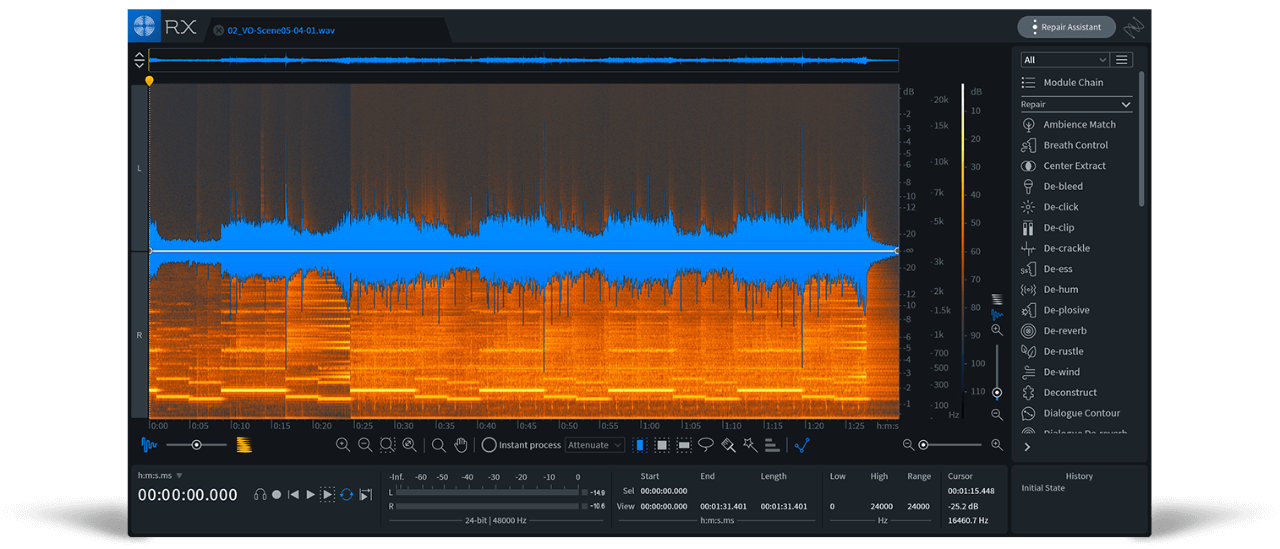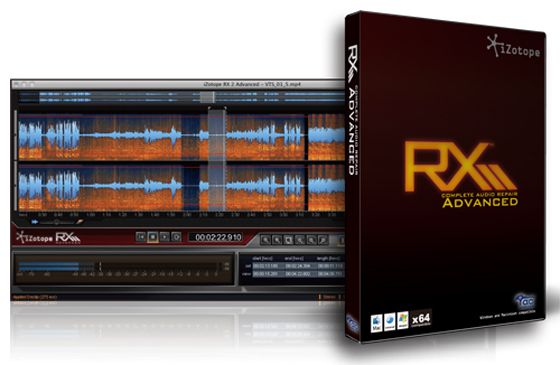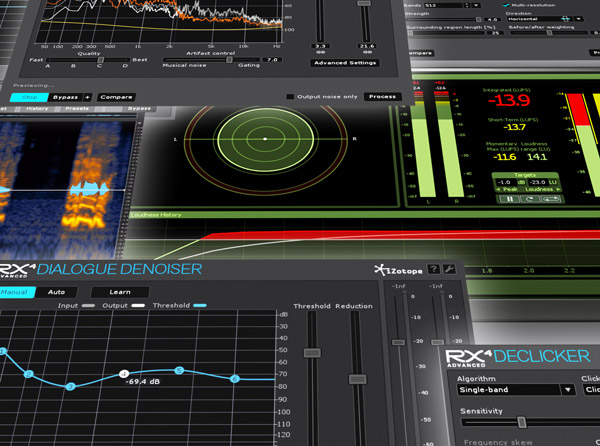In its time, iZotope RX3 Advanced offered the most comprehensive suite of noise-reduction software—available as a stand-alone application and as bundled plug-ins—for post-production sound, along with extensive metering, time- and pitch-shifting processors, resampling facilities and other invaluable tools. RX 4 Advanced ($1,199) adds several workflow accelerators used to comply with various loudness standards and to quickly adjust level, timbre and ambience in tracks.
I reviewed Version 4.0.1 of RX 4 Advanced (its plug-ins in AU format) using Digital Performer V. 8.06 and an 8-core Mac Pro running OS X 10.9.5. For a refresher on RX 4 Advanced’s legacy features, check out my review of RX3 Advanced in the May 2014, issue of Mix.
Streamlined Interoperability
RX 7 Advanced. Designed specifically for the demanding needs of post production professionals, RX 7 Advanced continues to lead the audio post production industry with powerful restoration tools used in major film and television projects worldwide. IZotope RX is the most complete audio restoration product on the market, a unique standalone application designed from the ground up to combat a range of audio problems. In addition to unique workflow features designed to help you get the best results, RX's powerful tools can do processing that plug-in based restoration products simply cannot do.
RX’s Spectral Repair plug-in—which was a bit of a kludge in previous releases—has been discontinued, made obsolete by the new RX Connect plug-in and alternative DAW interoperability. Roughly half of leading DAWs use RX Connect as a synchronized bridge to the stand-alone RX 4 Advanced application; you first select in your DAW the audio clip you wish to process, then launch RX Connect. Other DAWs (including DP) use RX 4 as an external editor: In DP, for example, you choose the RX application as DP’s external waveform editor and then open a region in RX via DP’s Audio menu.
No matter which protocol your DAW uses, after the RX application opens you can edit the selected clip using any processing (not just Spectral Repair) it provides. Different (fast and simple) methods are used, depending on your workstation, to return the processed clip back to your DAW in perfect sync with the original clip. Because some DAWs (including Pro Tools) monopolize the system’s audio drivers, an additional plug-in dubbed RX Monitor is included to enable hearing the RX application’s output; RX Monitor interacts with your DAW like an instrument to play the RX application’s audio through the DAW’s driver.
The updated Remove Hum plug-in and module—all modules belong to the standalone application—include an Adaptive mode that analyzes your audio and automatically notches out fundamental hum-related frequencies that change over time (such as in audio for a scene that was shot in multiple locations).
The updated Time & Pitch module provides an option to run Radius processing in real time, for those tasks in which you need fast processing. The tradeoff is lower quality than with offline processing (which is still available).
New Modules
The new Leveler module uses a compressor with automatic makeup gain to curb fluctuations in signal level. Use its Target RMS slider to adjust the K-weighted RMS level of your clip. The Speed slider alters how quickly gain is adjusted. Drag the Amount slider to limit the maximum amount of gain (boost or cut) that can be applied, and raise the Noise slider to reduce potential pumping when breathing or other broadband noise occurs during gaps in dialog. You can view the gain changes that Leveler applies and edit them by dragging up and down one or more nodes at once on a graphical curve (dubbed the Clip Gain envelope; see Figure 1).
The new Loudness module automatically applies a fixed amount of gain to your entire clip (or a selected region) to instantly make it comply with a specific standard, such as BS.1770, selected from a drop-down menu. Alternatively, you can use two sliders to manually set the desired loudness (in LKFS units) and maximum true peak level of the clip. A post-limiter is automatically applied as needed to meet the selected true-peak spec.
The new EQ Match module applies static equalization to purportedly make one region’s spectral balance conform to that of another. Simply select a region (such as a phrase in a VO track) that sounds great, click Learn, select another region that sounds bad, and click Process. EQ Match lets you save spectral profiles as presets, speeding your workflow.
The Ambience Match module does for noise what EQ Match does for timbre, with one caveat: It can’t decrease the amount of ambience that already exists in a selection; it can only increase it. This is an invaluable tool for matching an ADR track’s ambience to that of the recording being replaced. You simply make a selection of the noise in the live recording, click the module’s Learn button, make a selection in your ADR track where you want the same-quality noise added, drag the Trim control to adjust the level of the ambience to be added, and click Process. Noise snapshots can be saved as custom presets.
In Post-Production Sessions
I used RX 4 Advanced extensively while working on five video projects containing many dialog tracks, music and B roll. The new Leveler module gave me excellent results easily and exceedingly fast, smoothing levels no matter the track’s spectral balance. It controlled boomy-sounding peaks beautifully, often precluding the need to de-boom using multiband compression. With moderate settings—the Amount control set no higher than 4 dB—I got more natural-sounding results than when using my go-to compressors and limiters. After rendering the processing, I could mouse-drag one or more nodes at once in the automatically generated clip-gain envelope to alter Leveler’s gain changes in select spots (see Fig. 1).
The Loudness module conformed my mix to any of seven different loudness standards with just a couple of mouse clicks—a real timesaver. Using the Ambience Match module, I could capture the room tone on a dialog track and add it to another track that sounded too dead; a trim control let me adjust the level of the ambience ±6 dB without affecting the level of the dialog. Listening to the generated ambience in isolation, it was apparent it was synthesized. But in the mix, it worked inconspicuously if applied sparingly to tracks in select, short gaps.
I tried a couple dozen times to use EQ Match to smooth spectral balances on dialog tracks, but I always found I got better (and more predictable) results using a combination of static and dynamic equalization plug-ins.
Any editing performed on tracks in the RX application is destructive once sent back to DP (overwriting the original file everywhere it occurs in DP), a disadvantage compared to working with RX 4 Advanced’s nondestructive plug-ins. Overwritten files initially played back as—and looked like, in DP’s Sequence Editor—full-scale, broadband noise in DP; rebooting DP would always permanently restore pristine playback, but I’d sometimes also need to bounce the file to a new track to restore proper waveform display. This appears to be a bug in DP, not in the RX application.
On startup, the RX application would often arbitrarily reroute consistent output assignments to different MOTU I/O boxes or banks—sometimes to those disabled in the MOTU PCI Audio Setup utility. And I often heard distracting crackling noises and clicks while working with the application, especially while previewing a module’s processing. (An associate of mine confirmed hearing the same artifacts using RX 4 with a different system.) Thankfully, the artifacts did not print when files were overwritten back to DP; nor did they ever occur when using the RX plug-ins.
Purchase in Advance?
iZotope also offers a less-expensive “standard” version, which doesn’t include the Dereverb, Deconstruct, Leveler, Loudness, EQ Match, Ambience Match, Radius RT (Time & Pitch) and Insight (metering suite) modules and plug-ins. It also lacks the center-channel extraction and azimuth alignment features for the Channel Operations module and some extra controls for Denoiser, Spectral Repair and Declick. Many of these additional features included with the Advanced version have proven to be indispensible in my work; they are well worth the extra cost.
If you work in post-production sound, restoration or audio forensics and don’t already own RX3 Advanced, buying RX 4 Advanced is an absolute must—if only for its incredible legacy plug-ins. If you can tolerate the RX application’s intermittent routing and monitoring problems, the Leveler and Loudness modules make an upgrade from RX3 Advanced worthwhile.
Mix contributing editor Michael Cooper is a recording, mix, mastering and post-production engineer.
TRY THIS
DP can send only one region at a time to an external editor such as RX 4 Advanced. If you want to send an entire track containing non-contiguous soundbites, first make a time-range selection in DP for the entire track and select Merge Soundbites (option-shift-M).
I’ve used the sequential versions of iZotope’s RX Advanced stand-alone application and component plug-ins on all my post-production sessions for several years. With each new release, it keeps getting more powerful, versatile and, frankly, indispensable. The latest version, RX 6 Advanced, promises solutions to some of post’s most vexing and immutable noises that pollute dialog tracks, including wind and the sound of clothing brushing against a lavalier mic.
Other new processing modules (for the standalone application) and plug-ins aim to isolate dialog and reduce mic bleed, sibilance, mouth clicks, lip smacks and breathing noises. The new Composite View combines up to 16 active tabs into a summed spectrogram/waveform display and is useful when you want to apply the same spectral editing to all tracks at once. RX 6 Advanced can also export files in MP3 format.
Legacy processors—De-click, Voice De-noise, De-plosive, Ambience Match, Center Extract and Deconstruct—have also been improved, as has the Find Similar (event) tool. The Module List has been better or- ganized into Repair, Utility and Measurement categories, and you can save custom views of your go-to modules as presets for faster access.
RX 6 is available in three versions—RX Elements, RX 6 Standard and RX 6 Advanced. The Advanced version has the most features and highest price tag. The component plug-ins are available in AAX, Audiosuite DPM, Audio Units, RTAS, VST 2 and VST 3 formats. I used the AU plug-ins in Digital Performer 9, using an 8-core Mac Pro running OS X 10.9.5.
OFF THE AIR
One of three new modules in RX 6 Advanced that use machine learning and intelligent signal processing (the others are De-rustle and Dialogue Isolate), De-wind will reportedly only attenuate intermittent wind gusts that don’t distort a microphone; it regards constant wind noise to be part of the desired noise floor.
The module’s Crossover Frequency slider delimits how high in fre- quency (up to 1.5 kHz) the processing will act on the signal, while the Reduction slider sets the balance between wind-noise reduction and the original signal (see Fig. 1). The Fundamental Recovery slider re-synthesizes lower voice harmonics that have been obscured by wind noise, and the familiar Artifact Smoothing slider (also included in legacy noise-reduction modules) reduces watery-sounding artifacts that can occur with FFT-based processing.
I tried De-wind on the windiest track I could find in all my past post-production sessions—a female dialog track that was severely tainted by extremely strong low-frequency wind gusts that almost completely obscured the voice at times. Simply put, De-wind is a virtual hurricane shelter for dialog tracks. The module eliminated the track’s low-frequency wind gusts—gusts that, during the original session, the RX 5 Advanced De-noise plug-in could not completely quell.

A moderately loud, airy wind—naturally modulating slightly in intensity—remained. Another new module, Dialogue Isolate, dealt with that in short order. I simply boosted the Dialogue Gain slider to the max and lowered the Noise Gain slider all the way to favor speech over noise, then raised the Separation Strength slider slightly to 1.5 (on a scale of 0 to 10) to attenuate the wind. This transparently reduced wind noise to that of a light breeze (I could’ve attenuated it more), which made sense of waving vegetation in the video without sounding obtrusive.
Izotope Rx 4 Advanced Reviews

CLOTHES CALL, MOUTH OFF

The De-rustle module uses machine learning to attenuate the sound of clothing brushing against a lav mic. Two controls are all you need: Raise the Reduction strength slider to attenuate the rustling noise more (at the potential expense of speech clarity at high settings), and raise the Ambience preservation slider to retain more of the noise floor and background ambience (which De-rustle might otherwise remove).
De-rustle was very effective at reducing lav noise that was only about 3 to 6 dB lower than—and overlapping—male speech on the same track. Turning up the Reduction strength slider about two-thirds of the way attenuated the rustling noises almost to the point of inaudibility. The track suffered only a moderate reduction in depth, and clarity of speech was not noticeably impacted—an acceptable tradeoff. Once again, I was extremely impressed.
The new Mouth De-click module and plug-in are optimized for removing the sounds of mouth clicks and lip smacks. Aside from the fact that it includes no drop-down menu for selecting alternate algorithms, its control set and operation are the same as with the De-click module.
In A/B comparisons treating an adult fe- male dialog track, RX 5 De-click and RX 6 Advanced Mouth De-click were equally effec- tive at removing extremely loud mouth clicks and lip smacks vented by an off-mic, hyperactive child (up to 6 dB louder than the adult’s speech!). Mouth De-click, however, better-pre-
served bass spectra in the underlying track and introduced far less audible watery-sounding artifacts—a definite improvement.
MUSIC PRODUCTION
The new De-bleed module attenuates or removes bleed in a track from an off-mic source. To use De-bleed, you have to import two tracks into the standalone RX 6 Advanced application: the track containing both desired audio and unwanted bleed (“Active Track”), and a track that contains only the audio from the source of the bleed (“Bleed Source Track”). (iZotope doesn’t recommend using De-bleed in Composite View to treat multiple tracks at once.) The two tracks must have matching sampling rates and be time-aligned within a few milliseconds of each other.
The De-bleed module is used on the Active Track. In De-bleed’s interface, you select the Bleed Source Track from a dropdown menu. After making a time-range selection in the Active Track where the bleed is most apparent, click on De-bleed’s Learn button to initiate the module’s analysis of the problem. After the analysis is complete, the center of the interface shows a spectral display of either the Bleed Source Track or Active Track, depending on which associated button you click (see Fig. 2). Drag the Reduction strength slider to the right to progressively remove more bleed, and ad- just the Artifact Smoothing slider as needed to avoid unnatural sound.
I used De-bleed on multimiked tracks for a male singer who was simultaneously playing acoustic guitar. De-bleed did an amazing job reducing guitar bleed into the singer’s mic. Any higher than a 0.3 Reduction strength setting (very low) thinned the singer’s deep bass register. But even such ostensibly light processing was remarkably effective at reducing bleed to an acceptable level.
Used on the same vocal track, the new Breath Control module was both extremely effective and transparent. The module has two modes of operation: Gain mode applies the same amount of gain reduction to all detected breaths, while Target mode lowers only loud breaths to your specified target level.
I also got fantastic results on the same track using the new De-ess module (also available as a plug-in), which lets you use either a spectral or more conventional mode of processing. Spectral mode uses multiband compression (using dozens of bands) and spectral shaping to achieve ultra-smooth and transparent results—without audible modulation—on complex programs. Love it!
Izotope Rx 4 Advanced Reviews
Obviously, De-bleed, Breath Control and De-ess also have uses in post-production. And while there are other de-essers and breath attenuators available (including impressive plug-ins made by iZotope), many of RX 6 Ad- vanced’s other new modules offer veritable breakthroughs in audio repair, effectively eliminating noise that was heretofore impossible to remove. RX 6 Advanced is a stunning achievement and a must-have for anyone working in post-production.